The secret to designing your sound system is to start at the ears.
The design of an IP paging system starts with the sound level required for people to hear an announcement. Once we know the right sound level, we can define everything else.
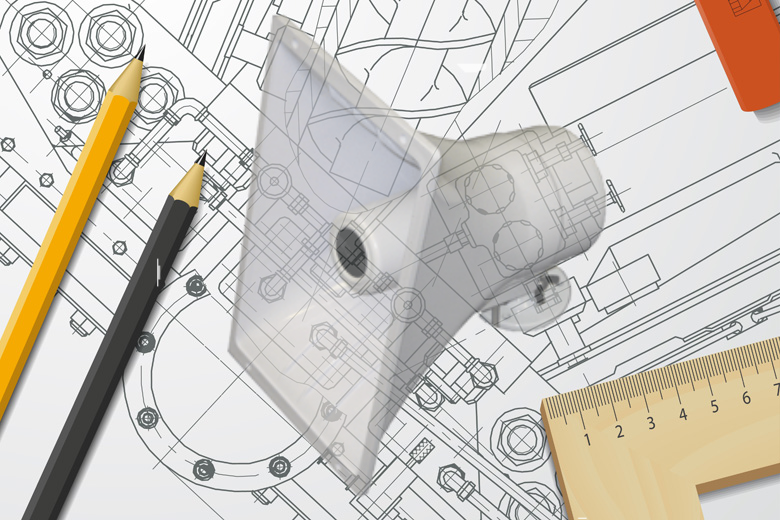
The sound level we hear is affected by the background noise, the distance from the IP speaker, and if we are indoors or outdoors.
We require different paging equipment if the system is used in an office building, or a noisy manufacturing plant. We select different IP speakers and amplifiers when we are inside a classroom, or when we are in the hallways of the school. This article describes how to calculate the speaker, the power required at each speaker, and the best place to mount the speakers.
How Sound is Measured – The Decibel
Sound level is measured in dB or decibels. This is a relative measurement that starts at 0 dB, which is the lowest sound level that a healthy ear can hear. It measures the relative difference between sounds levels. Sound travels through a medium such as air or water to be heard. That’s why you can’t hear anything in a vacuum. It creates slight changes in the pressure of the medium, which are defined as sound pressure changes. The decibel level is a measure of this sound pressure level change in the air. It is also measured at a specific frequency.
There are two types of sound specifications that help us define the right type of IP paging system. There are the frequency response curves that define what we can hear, and there are amplifier and speaker frequency curves that define what our paging system can provide.
What We Can Hear
Most people can hear sound at 1000 Hz but we may not hear any sound at over 20,000 Hz. This variance in the perceived sound levels at different frequencies is measured using a slightly different measurement called dBA or A-weighting.
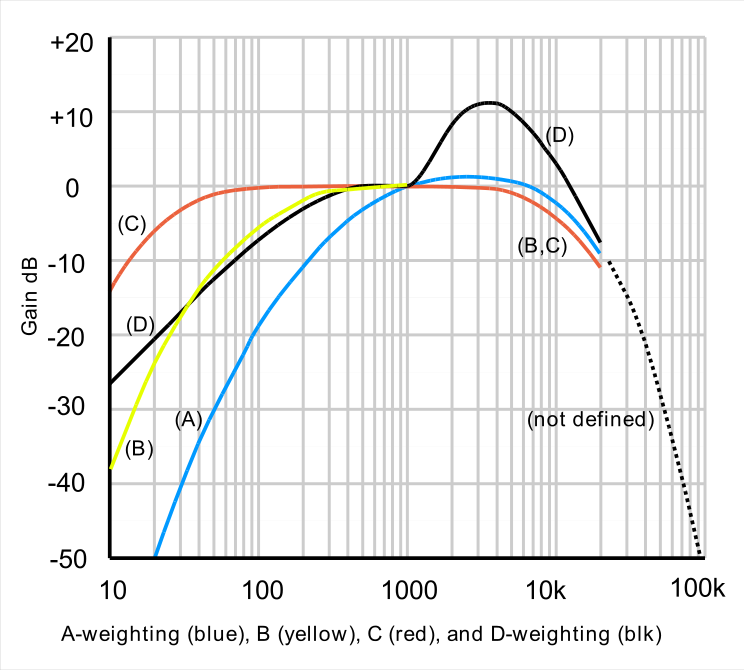
A-weighting consists of a family of curves that relate frequency (Hz) and perceived sound level (dB). There are A, B, C, D, and Z weightings curves. The A-frequency chart was the first one used, and it’s used by the international standard IEC 61672.
What the Paging System Can Provide
The output audio quality from the IP paging system is determined by the amplifier and the speaker frequency response. The “speaker frequency response” curve define what the speaker is capable of providing. The curve shows the speaker audible response (dB) at a range of frequencies. When we select the speaker, we look at this curve to determine if it can be used for voice or music.
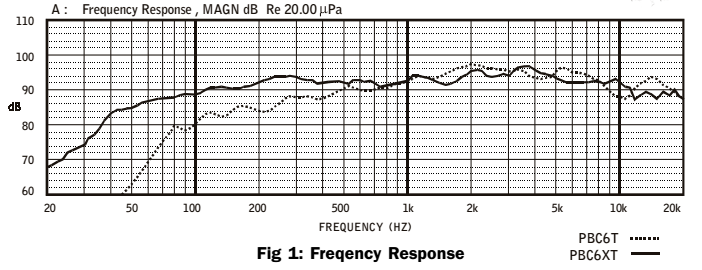
Even though there are a number of ways to measure sound, we usually stick to a simplified measure that just measures the dB at a certain frequency. When you look at the specifications for a speaker, it will define the sound level (in dB), 1 meter away, using 1 watt of power, and at a specific frequency.
Sound at the Ear
The normal sound level of a person talking is about 60 dB. At this level, we can easily hear a person talking, but if we are outside and there is traffic noise, we may not be able to hear them. There are two factors that affect how we hear something, one is the background noise and the other is indoor or outdoor location. If we are indoors, the sound seems louder because it can echo off the surrounding walls and ceiling. Outdoors the sound dissipates and it’s harder to hear. As a rule of thumb, we suggest providing a sound level that’s about 10 dB above the background noise.
To learn more about sound levels, look at our article, What is The Right Sound Level for Your Paging Speakers.
Sound Levels at a Distance
Sound levels decrease as we move away from the source of the sound. The inverse square law defines the sound level at a certain distance. According to this law, the sound pressure level is inversely related to the radius from the source (1/r2).
This law works best in an ideal environment, where the sound propagates equally in all directions, and there are no reflective surfaces.
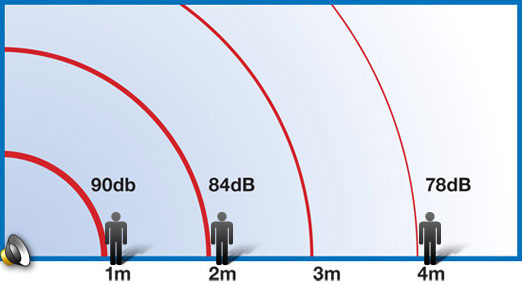
Instead of calculating the sound level based on the inverse square law, we use a simple rule of thumb. The sound level decreases by 6 dB for every doubling of the distance from the speaker. In the chart above, the 90 dB sound level drops to 84 dB (90 – 6 = 84) when we are 2 m away, and 78 dB when we are at 4 m away.
Selecting the Speaker and Amplifier
Suppose we want to hear a page from a speaker that’s 8 meters (26 ft.) away. Here’s how we calculate the sound level required at the speaker. Suppose we are in a busy building lobby and the background level is 70 dB. The person will need to hear sound levels at 80 dB to hear above the background noise (10 dB more than the background). Let’s assume that the speaker is 8 meters (26 ft.) away. Now that we know the sound level at the person, we can select the speaker and the amplification power we will require to achieve this sound level.
As we move closer to the speaker the sound level increases. At half the distance (4 m) the sound level is 6 dB more or 86 dB, at half of the remaining distance (2 m), the sound level is increased another 6 dB (to 91 dB), and finally at half of that (1 m), we need the speaker to provide 97 dB at 1 m.
Now that we know the sound level, we can select the speaker and the amplifier power required. As I mentioned, speakers are specified by their dB level at 1 m at 1 watt of sound power. For example, the wall speaker, model PBC6XT72K, can provide 91 dB a 1 watt, at 1 meter. Since we need 97 dB, we need to increase the amplification provided by our IP amplifier. In this application we have selected the IP7-SE8 network attached amplifier from Digital Acoustics. We can adjust the power to the speaker.
The amplification of the sound level to the speaker increases the sound output. The rule of thumb is that doubling the power will increase the sound level by 3 dB. At 2 watts, the speaker will put out 94dB (91 dB + 3 dB = 94dB). By doubling the power to 4 watts, we get another 3 dB or 97dB.
In summary, the speaker required for this application is model PBC6XT72K, the IP7-SE8 amplification power should be set at 4 watts, and the speaker on the wall, is 8 meters away from where the sound will be heard.
To learn more take a look at our article, Selecting the Right Speakers for Your Paging System. It reviews the different speakers and where they should be placed.
Real World Considerations
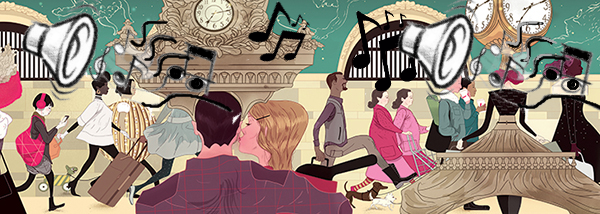
In the real world, we may need to adjust the volume from the speaker. There may be people further away from the speaker, or too close to the speaker. We should be careful because people who are very close to the speaker (1 meter away) will hear a sound level of 97 dB. This may be too loud in some situations because repeated exposure to sound above 85 dB can cause hearing damage and should be avoided. The best way to solve this problem is to use more speakers that are placed closer to the people. For example, instead of using one speaker on a wall, we could use a number of speakers in the ceiling.
In most cases, paging systems are used for voice announcements. If we want to support high quality music, we may select a different paging system. A system that supports a wider audio range will cost more so we need to make sure we understand our objectives.
Summary
We select the speaker and the power required based on the sound level we want to hear. We can use the speaker specifications, and then use the distance calculations and speaker power to adjust the sound level.
If you need help selecting your IP paging system, please contact us at 800-431-1658 in the USA, or at 914-944-3425 in the USA, or just use our contact form.